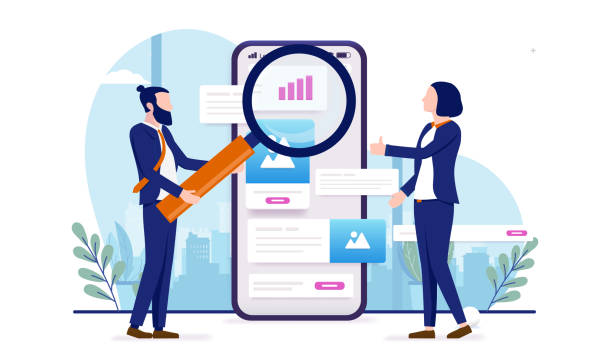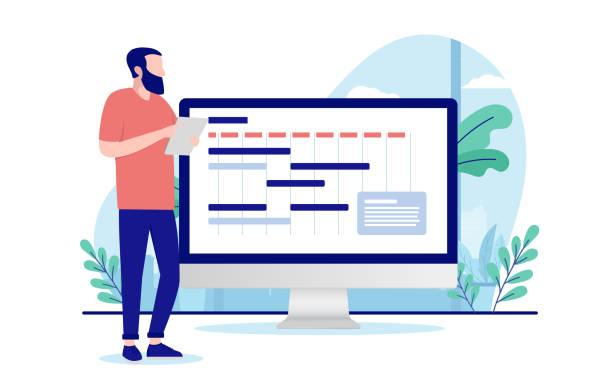Introduction to the Importance of Multilingual Website Design in the Age of Globalization

In today’s world, where geographical boundaries have faded due to the internet, #reaching_global_audiences is no longer a dream but a business necessity.
Multilingual Website Design has become a powerful tool for companies and businesses to convey their message to audiences worldwide.
This approach goes beyond mere text translation; it signifies a deep understanding of cultural differences, regional preferences, and consumer behavior in various markets.
Have you ever considered how a single-language website overlooks the enormous potential of international markets? This is a #thought-provoking_question that every business should ask itself.
In fact, many users prefer to receive information in their native language, and this can directly impact conversion rates and customer loyalty.
According to recent research, multilingual websites not only help increase organic traffic but also enhance brand credibility on a global level.
This #educational introduction will help you understand the importance of this field.
Are you dissatisfied with the low visitor-to-customer conversion rate on your e-commerce website?
Solve this problem permanently with professional e-commerce website design by Rasaweb!
✅ Increase visitor-to-customer conversion rates
✅ Create an excellent user experience and build customer trust
⚡ Get Free Consultation
Exploring the Competitive Advantages of Multilingual Websites

Multilingual website design means opening new gates to countless opportunities.
The first and most important competitive advantage is a significant expansion of the target market.
A single-language website can only reach a limited percentage of the world’s online population; whereas a multilingual site can provide services to millions of new users who speak other languages.
This approach not only leads to increased traffic but also creates a greater chance for attracting new customers and boosting international sales.
The second advantage is a significant improvement in local and international SEO.
By creating localized content for each language, your website will achieve better rankings in search engines for those languages, which means greater visibility and attracting more targeted customers.
The third advantage is increased user credibility and trust.
When a company takes the effort to localize content for its customers, it demonstrates respect for their culture and language, which in turn strengthens trust and loyalty.
This descriptive section provides a comprehensive analysis of these advantages and offers the necessary guidance for businesses to capitalize on these opportunities.
Finally, multilingual websites allow you to significantly improve the user experience by offering customer service in different languages, and this itself becomes a sustainable competitive advantage.
Technical Considerations and Platforms in Multilingual Website Design

Multilingual website design requires precise technical considerations and the selection of an appropriate platform.
This #specialized section delves into the technical aspects.
One of the first decisions is choosing the URL structure.
Should subdomains (e.g., en.example.com), subfolders (e.g., example.com/en), or independent domains (e.g., example.co.uk) be used? Each option has its own advantages and disadvantages in terms of SEO and management.
The subfolder option is generally the preferred and recommended choice for management and SEO.
Table 1: Comparison of Popular Platforms for Multilingual Websites
| Platform | Multilingual Capability | Scalability | Plugin/Module Requirement |
|---|---|---|---|
| WordPress | High (with plugins like WPML, Polylang) | Medium to High | Yes |
| Joomla | Good (native support) | Medium to High | No (core content) |
| Drupal | Very High (strong native support) | High | No (core content) |
| Shopify | Medium (with apps or themes) | Medium to High | Yes |
Furthermore, choosing a Content Management System (CMS) with native multilingual capabilities or powerful plugins is essential.
WordPress, Joomla, and Drupal are among the most popular options.
WordPress, with plugins like WPML and Polylang, provides the ability for multilingual website design, while Drupal and Joomla have stronger native multilingual support.
Another point is how to manage the database for multilingual content to ensure that each language is correctly linked to its respective version and to prevent 404 errors or duplicate content.
Finally, web hosting and servers must also be capable of supporting high traffic volumes and providing suitable loading speeds for users from different parts of the world.
This #practical_guide section offers important technical decision-making advice.
Content Translation and Localization Strategies

After technical considerations, multilingual website design moves to the crucial aspect of content translation and localization.
This process goes far beyond word-for-word translation; rather, it requires a deep understanding of cultural context, idiomatic expressions, and even the audience’s sentiment.
The first choice is between machine translation and human translation.
While machine translation (like Google Translate) is fast and cheap, it lacks the necessary accuracy and quality for professional and sensitive content and can harm brand credibility.
For important content such as product descriptions, services, and main website materials, human translation by native and specialized translators in the field is essential.
Localization is the next step, which involves adapting content to local culture and customs.
This includes aspects like currency, date and time formats, phone numbers, addresses, colors, images, and even writing tone.
For example, an advertising campaign that was successful in one country might fail in another due to cultural differences.
Choosing appropriate images that are compatible with the target culture is very important.
Also, attention must be paid to the tone and communication style; is a more formal or a friendlier tone appropriate? This #explanatory and #educational section helps you implement successful strategies for localizing your content.
Finally, having a specialized glossary and a style guide for translators will ensure consistency and quality of content across all languages.
This attention to detail in localization significantly enhances the user experience and greatly contributes to the success of multilingual website design.
Did you know that poor online store design can drive away up to 70% of your potential customers? Rasaweb transforms your sales with professional and user-friendly e-commerce website design.
✅ Significant increase in sales and revenue
✅ Full optimization for search engines and mobile
⚡ [Get Free Consultation from Rasaweb]
Search Engine Optimization (SEO) for Multilingual Websites

For the success of multilingual website design, optimizing for search engines (SEO) in each language is vital.
This #specialized and #guidance section delves into the details of multilingual SEO strategies.
The most important tool in this regard is the correct use of the `hreflang` tag.
This tag informs search engines like Google which version of the page is appropriate for which language and region.
Incorrect use can lead to duplicate content issues, so precision in its implementation is essential.
For example, `<link rel=”alternate” href=”http://example.com/en-us” hreflang=”en-US” />` is used for English-speaking users in the United States.
Keyword research for each language is also a crucial step.
Directly translated keywords often do not perform as expected, because the search behavior and terminology used differ in each language and culture.
It is necessary to use keyword research tools specific to that language and country.
For example, German users might use a completely different term for a specific product compared to English speakers.
Furthermore, Geo-targeting is also of high importance.
Using tools like Google Search Console, you can specify which language version is intended for which geographical region.
This helps search engines deliver relevant content to users in different regions.
The internal and external link-building structure must also be carefully managed for each language.
Linking to relevant language versions helps increase the authority and ranking of pages in those languages.
Correct implementation of these SEO principles for multilingual website design ensures visibility and attracts targeted traffic from international markets.
This is a crucial aspect that should not be overlooked.
Common Challenges and Solutions to Overcome Them

Although multilingual website design offers numerous benefits, it also comes with challenges that need to be addressed.
This #thought-provoking_content and #guidance section will help you identify these challenges and find solutions for them.
One of the biggest challenges is initial costs and maintenance.
Professional translation, localization, and ongoing content management in multiple languages can be expensive.
The solution is to start by setting a realistic budget and prioritizing languages based on potential Return on Investment (ROI).
For example, you don’t need to have complete content for all languages initially; you can start with the most important markets.
Another challenge is content and update management.
When new content is added or a change is made to one version of the site, it must be ensured that all language versions are also updated.
Using a Translation Management System (TMS) or a CMS with strong multilingual capabilities can automate and simplify this process.
Translation and localization quality is also a major concern.
Poor or culturally inappropriate translations can harm the brand.
Investing in native and specialized translators familiar with your field of activity, as well as conducting thorough quality checks, will resolve this issue.
Continuous team training and providing a glossary and style guide ensure that translations are always of high quality and consistent.
Multilingual SEO issues, such as incorrect hreflang tags, can lead to ranking problems.
Close monitoring of Google Search Console and using hreflang validation tools are essential.
By properly managing these challenges, multilingual website design can become a sustainable competitive advantage.
Modern Tools and Technologies in Multilingual Content Design and Management

In today’s world, advanced tools and technologies have emerged that facilitate the process of multilingual website design and its content management.
This #news and #specialized section introduces some of these tools.
Translation Management Systems (TMS): These platforms help organize and automate the translation process.
They facilitate collaboration among translators, project managers, and reviewers and leverage tools like Translation Memory (TM) and Terminology Database (TermBase), which help maintain consistency and reduce costs in the long run.
Tools such as Trados Studio, MemoQ, and Smartcat are prominent examples of TMS.
Table 2: Useful Tools for Multilingual Website Design
| Tool/Technology | Primary Use | Key Advantages |
|---|---|---|
| WPML/Polylang (for WordPress) | Multilingual content management in CMS | WordPress integration, simple user interface |
| Trados Studio | CAT software (Computer-Assisted Translation) | Translation memory, terminology database, increased speed |
| Google Translate API | Machine translation for low-priority or preliminary content | Speed, low cost, ease of implementation |
| Smartcat/Crowdin | Cloud translation platforms | Team collaboration, CMS integration, project management |
Artificial Intelligence and Neural Machine Translation (NMT): Significant advancements in AI, especially in Natural Language Processing (NLP) and Neural Machine Translation (NMT), have dramatically improved the quality of machine translation.
Although it still doesn’t replace human translators, it is used for high-volume and low-priority content or as a pre-translation tool, which speeds up the work of human translators.
Cloud Localization Platforms: Tools like Crowdin and Lokalise provide cloud-based localization project management, which simplifies and streamlines the collaboration process.
These platforms often integrate with development systems and CMS.
Intelligent use of these technologies makes the multilingual website design and maintenance process much more efficient, allowing businesses to reach new markets more quickly.
User Experience (UX) in Multilingual Websites

Multilingual website design is not limited to content translation; User Experience (UX) also plays a vital role in its success.
Good UX ensures that users can easily access their desired language and interact with the content.
This #explanatory and #educational section covers the most important aspects of UX in multilingual websites.
One of the first and most important elements is the Language Switcher.
This option should be easy to find (usually in the header or footer) and clearly displayed (such as a dropdown menu with language names).
Using flags is not recommended, as one flag might represent multiple languages or be perceived as offensive (e.g., the U.S. flag for the English language, while many other countries are also English-speaking).
It is better to use the full names of the languages (e.g., “English”, “Français”, “فارسی”) or language codes (e.g., “EN”, “FR”, “FA”).
Writing Direction and Layout: Some languages, such as Persian and Arabic, are written Right-to-Left (RTL), while most European languages are Left-to-Right (LTR).
User interface design must consider this and adjust the layout of pages, menus, images, and even forms accordingly.
This includes mirroring some UI elements for RTL languages.
Fonts and Typography: Ensure that the selected fonts for each language support all relevant characters and letters and provide good readability.
A font suitable for English might not be effective for Persian or Chinese.
Dynamic and Localized Content: Dynamic content such as dates, times, prices, phone numbers, and addresses should be automatically displayed based on the user’s region and language.
This gives users a greater sense of nativeness and comfort.
By paying attention to these details in multilingual website design, you can provide a flawless and pleasant experience for users worldwide and increase their satisfaction.
Does your company website perform as well as your brand deserves? In today’s competitive world, your website is your most important online tool. Rasaweb, specializing in professional corporate website design, helps you to:
✅ Gain customer credibility and trust
✅ Convert website visitors into customers
⚡ Get a free consultation!
Performance Evaluation and Success Metrics for Multilingual Websites

After implementing multilingual website design, the critical stage of performance evaluation and success measurement arrives.
This #analytical and #educational section shows you how to measure Return on Investment (ROI) using Key Performance Indicators (KPIs) and analytical tools.
Website Traffic by Language/Region: Using tools like Google Analytics, you can view the amount of incoming traffic to each language version of your site.
This shows you which languages attract the most visitors and have growth potential.
Also, you can analyze the geographical location of visitors to ensure that traffic matches your target markets.
Conversion Rate: Are users in different language versions equally successful in performing your desired actions (purchase, registration, download)? The conversion rate is one of the most important indicators of success.
If the conversion rate is low in a specific language, it may indicate a need to improve translation quality, content localization, or even user experience in that language.
Time on Site and Bounce Rate: Higher time on site and lower bounce rate indicate greater user engagement with the content.
Analyzing these metrics for each language helps you gauge user interest and satisfaction.
High-quality and localized content can help improve these metrics.
Search Engine Results Page (SERP) Ranking: Monitoring the ranking of localized keywords in search engines for each language indicates the effectiveness of your multilingual SEO strategy.
SEO tools can help you track these rankings.
User Feedback: Surveys, feedback forms, and analysis of user comments on social media can provide valuable information about translation quality, user experience issues, and unmet needs.
By meticulously tracking these metrics, you can identify the strengths and weaknesses of your multilingual website design and implement necessary improvements to increase efficiency and global success.
The Future of Multilingual Website Design and Upcoming Trends

Multilingual website design is rapidly evolving and transforming.
This #analytical and #news section examines future trends and technologies that will change the landscape of the multilingual web.
Artificial Intelligence and Real-time Translation: Significant advancements in AI, especially in Natural Language Processing (NLP) and Neural Machine Translation (NMT), are moving towards higher quality and real-time translations.
In the near future, we may see websites that dynamically translate and localize content for users in real-time, without the need to create separate versions.
This could revolutionize the multilingual website design process and drastically reduce maintenance costs.
Content Personalization based on Language and Region: Beyond mere translation, the future is moving towards delivering personalized content based on the cultural and behavioral preferences of each user in their native language.
This includes displaying products, services, and even promotional offers specifically optimized for that local market.
This approach signifies a much smarter and more dynamic multilingual website design.
Multilingual Voice Search: With the increasing use of voice assistants and voice search, optimizing content for voice queries in different languages will become increasingly important.
This requires understanding speech patterns and colloquialisms in each language.
Augmented Reality (AR) and Virtual Reality (VR) in Multilingual Content: As AR and VR become more integrated into the web, providing multilingual experiences on these platforms will also gain importance.
This could include translating texts in AR environments or VR user interfaces with multilingual support.
This topic can add a #fun and engaging aspect to multilingual website design.
These trends indicate that multilingual website design is not only a current necessity but also a field full of innovation and future opportunities.
Frequently Asked Questions
| Question | Answer |
|---|---|
| What is a multilingual website? | A website whose content is available to users in more than one language. |
| Why should I make my website multilingual? | To reach more audiences in global markets, improve user experience, and enhance international SEO. |
| What are the technical approaches to building a multilingual website? | Using subdirectories, subdomains, or URL parameters to differentiate languages. |
| How does multilingual design affect SEO? | By targeting local keywords and providing content in users’ native languages, the website’s ranking in search engines for those regions improves. |
| What are the challenges of multilingual website design? | Content translation management, Right-to-Left (RTL) direction support, technical issues related to language addressing, and maintaining design consistency. |
| How to choose languages for a multilingual website? | Based on target audience analysis, target markets, and current website traffic data (if available). |
| What is RTL support and why is it important for some languages? | Right-to-Left refers to the display direction of text and page elements from right to left, which is essential for languages like Persian, Arabic, and Hebrew. |
| How to manage multilingual website content? | Using Content Management Systems (CMS) with multilingual capabilities, translation plugins, or professional translation services. |
| How is user experience (UX) in a multilingual website? | It should be easy to change languages, and the translated content should be of high quality so that users feel comfortable. |
| What are the common CMS platforms for multilingual websites? | WordPress (with plugins like WPML), Joomla, Drupal, and Shopify (with relevant settings or plugins). |
And other advertising services of Rasaweb Advertising Agency in the field of advertising
Smart Digital Advertising: A fast and efficient solution for analyzing customer behavior with a focus on attractive user interface design.
Smart Brand Identity: A professional solution for digital branding with a focus on attractive user interface design.
Smart Reportage: A dedicated service for improving SEO ranking based on user experience customization.
Smart Digital Branding: A combination of creativity and technology to increase sales through SEO-driven content strategy.
Smart Custom Software: A fast and efficient solution for increasing click-through rates with a focus on using real data.
And over hundreds of other services in the field of internet advertising, advertising consulting, and organizational solutions
Internet Advertising | Advertising Strategy | Advertorial
Resources
Iranian Host Multilingual Website Guide
Multilingual SEO at Webram
Faradars Multilingual Website Design Training
Hostiran Global Website Expansion
❓ In today’s competitive world, your powerful online presence gains meaning with Rasaweb Afarin. We are by your side to elevate your business with our expertise in user-friendly website design, SEO, and digital marketing. To start a digital transformation, contact us today.
📍 Tehran, Mirdamad Street, next to Central Bank, Southern Kazeroun Alley, Ramin Alley, No. 6




